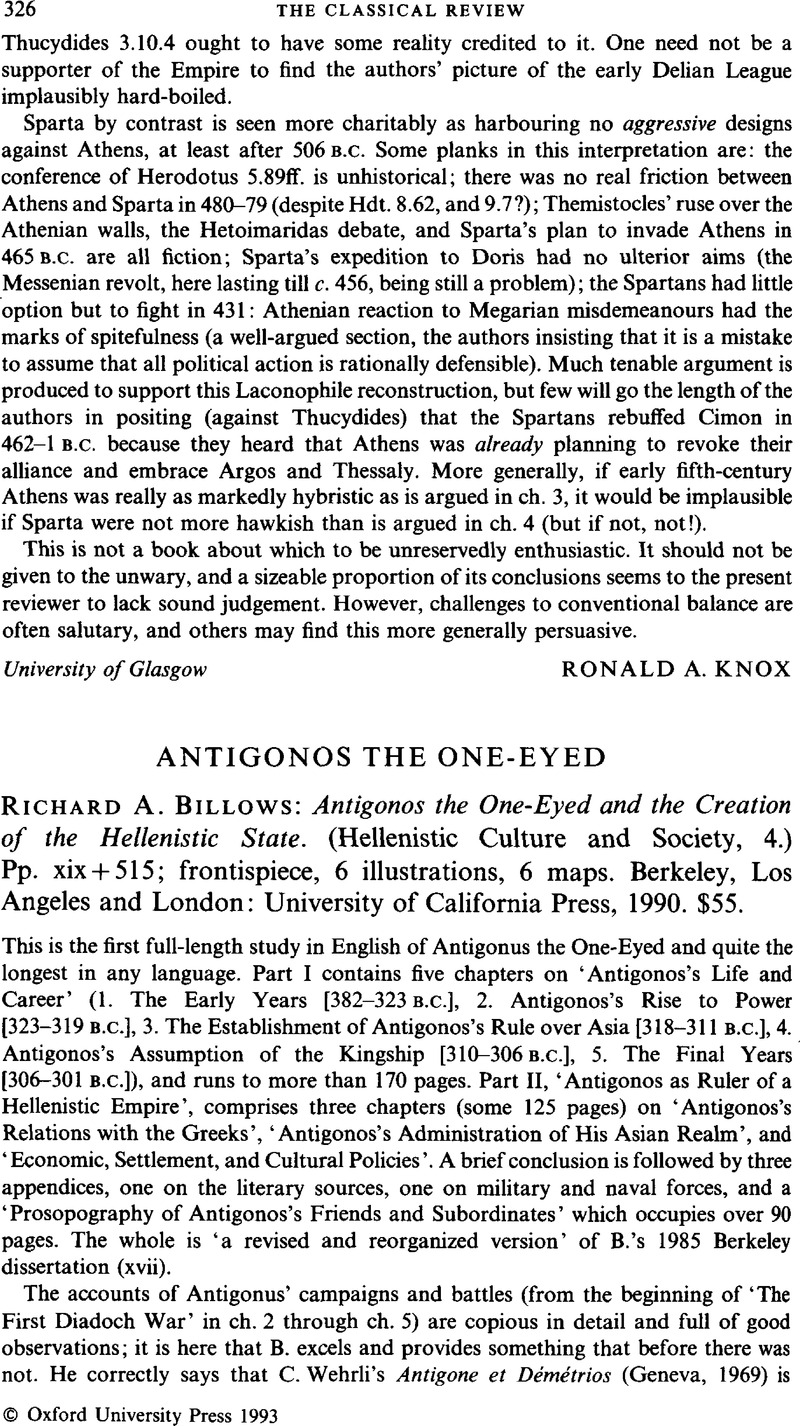No CrossRef data available.
Published online by Cambridge University Press: 16 February 2009

1 B. is keen elsewhere, too, to associate Antigonus with Philip and not with Alexander (cf. 321). This idea goes back to Wilamowitz (Hellenistische Dichtung i 6; cf. Wehrli, 103).
2 After some of what is said in the course of the discussion, B.'s conclusion (236) comes as something of a surprise: ‘[Antigonos] was not motivated by a disinterested love of the Greeks, or of freedom as such; he did limit the freedom of the Greeks; his pronouncements on Greek autonomy were self-interested. But having decided, as a self-interested act of statesmanship, on a policy of gaining the goodwill of the Greeks, he applied it with all the rigor and tenacity that circumstances permitted, and so deserves to be called the most philhellene of the kings of his time, for he could have acted otherwise.’ Apart from the imputation of motive implied in the statement about ‘rigor and tenacity’, this is pretty unexceptionable. There is, in the end, not a lot between B. and Wehrli, except perhaps that the latter is more subtle.
3 The feeling of unease extends beyond this section. B. gives a list of ‘Epigraphic Sources’ (466–7), prefaced with: ‘Many of the following inscriptions have been published or discussed several times; I list only one publication of each, which seems to be the most useful and/or accessible.’ I am not sure in general that this is helpful. Does it make sense, e.g., to give OGIS 5, OGIS 8, Syll. 3 344 instead of Welles, Royal Correspondence 1, 2, 3/4? (Welles, it should be said, is mentioned in the text on some of the occasions when these are at issue.) On the Hellenic League of 302, it would surely have been good to refer (in the list and in the text) to Schmitt, Staatsverträge 446 and Moretti, ISE 44. At the particular level, some examples follow. In the list itself SEG i.354 appears, which has been superseded by Habicht, Ath. Mitt. 1957, 186 no. 21 (a separate entry in the list); similarly with SEG i.358 and Habicht, Ath. Mitt. 1957, 188 no. 22 (both are in the list). Schede, Ath. Mitt. 1919, 12 no. 5 O is listed, as is its reproduction as SEG i.360 in a separate entry. SEG xiv.60 must be a mistake for something else. The entry for Drakon (36) in the Prosopography gives as sources Schede, Ath. Mitt. 1919, 6 no. 5 H, and Habicht, Ath. Mitt. 1957, 〈186〉 no. 21, and amongst the further reading SEG i.354: SEG i.354 = Schede's no. 5 H, and Habicht's no. 21 is a more complete version of the same text. Similarly for Hipparchos (52), with Habicht, Ath. Mitt. 1957, 188 no. 22 listed as source, and SEG i.358 (an earlier and less full version of the same text) as further reading. The anonymous 142 and 143 in the Prosopography are given as, respectively, ‘an aide of Demetrios’ and ‘an officer of Demetrios’. Habicht, Ath. Mitt. 1957, 178 no. 13 is cited, where (lines 3–4) two (or more) men are referred to only as [διατρ⋯] | [βοντ]ες παρ⋯ δ[ημητρίωι …]. In the entry on Zenodotos (120) B. disagrees with Wilhelm, perhaps revealingly. I have not checked everything. One might add to the Prosopography Aristolas and Sostratos on the strength of SEG xxix.94 with Habicht, Untersuchungen (Vestigia 30) 4–6 (esp. 6 n. 28 including the possibility of identifying this Sostratos with the Sostratos honoured at Ephesos [B.'s no. 109, to which entry this might be added]).
4 Regarding other aspects of ‘administration’, the evidence is not such as to permit of much substantial advance. In the understandable quest for this, formal language can come to be misused. It is, for example, overzealous of B. to suggest that the Chaereas of Sardis vii.l no. 1 ‘may have been a dikastēs’ (229), and the description of the Polyarchos of Diod. 19.91.3 as ‘apparently a dioikētēs (financial controller)’ (279) verges on the irresponsible. (About this man, Diodorus reports that he came μετ⋯ στρατιωτ⋯ν πλει⋯νων ἤ χιλíων, which B. purposefully renders as ‘a little more than 1000 soldiers’ [ibid.].)